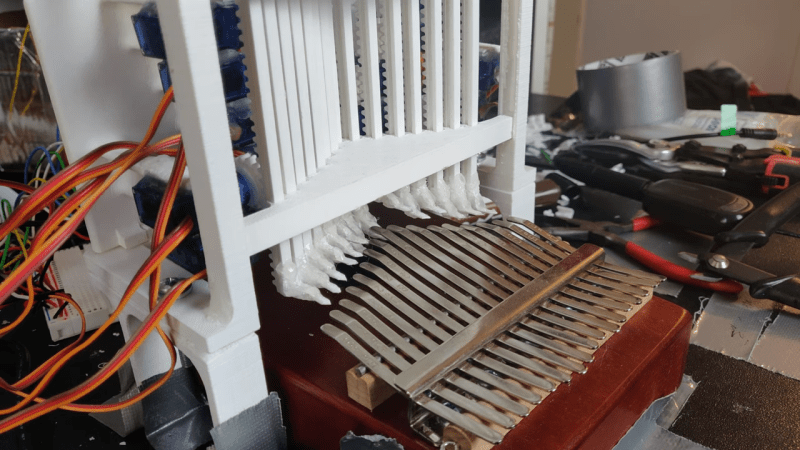Would you like to know the great thing about this community we have here? All the spitballing that goes on every day in the comments, the IO chat rooms, and in the discussion threads of thousands of projects. One of our favorite things about the Hackaday universe is that we help each other out, and because of that, our collective curiosity pushes so many designs forward.
 [Gurpreet] knows what we’re talking about. He’s back with version two of his self-playing kalimba, driven as strongly as ever by the dulcet tones of the Avatar theme. Now the robo-kalimba is rocking two full octaves, and thanks to your comments and suggestions, has relocated the servos where they can’t be picked up by the soundboard.
[Gurpreet] knows what we’re talking about. He’s back with version two of his self-playing kalimba, driven as strongly as ever by the dulcet tones of the Avatar theme. Now the robo-kalimba is rocking two full octaves, and thanks to your comments and suggestions, has relocated the servos where they can’t be picked up by the soundboard.
We gasped when we saw the new mechanism — a total of 15 rack and pinion linear actuators that make the kalimba look like a tiny mechanical pipe organ. Now the servos float, fixed into a three-part frame that straddles the sound box. [Gurpreet] melted servo horns to down to their hubs rather than trying to print something that fits the servos’ sockets.
Thumb your way past the break to check out the build video. [Gurpreet] doesn’t shy away from showing what went wrong and how he fixed it, or from sharing the 3D printering sanity checks along the way that kept him going.
Plucking kalimba tines is a difficult problem to solve because they’re stiff, but with timbre sensitive to many degrees of pressure. A slightly easier alternative? Make a toy player piano.















Am I the only one that read the headline as if it were being read aloud on NPR?
Am I the only one that read the headline in their head as if they were hearing it on NPR?
Maybe I’m wrong, but servos seem like unnecessarily slow overkill here – there’s no proportionality needed while plucking the individual notes, so a solenoid might be more responsive.
What benefits would responsiveness provide?
The ability to play successive notes faster.
That was my thought as well. Solenoids would be faster, simpler to control, and no plastic gears to potentially break.
I kept burning up my transistors when I tried out solenoids. I had the right circuit except the nothing would happen when i turned it on. My thinking was that i didn’t have enough wire turns for it to work at that amperage so i tried to up the amperage by lowering the resistance and *poof* my transistor would release the magic smoke. So i either needed to spend way too much time coiling wire or buy some beefier transistors. Either way, servos were a faster solution that I knew would work.
If you want to make solenoids yourself, you should use a drill to speed up the coil winding. But of course, where you can find cheap servos, you should also be able to find cheap solenoids.
Thats a good point. Im not sure if solenoids along with a driving transistor circuit would have been cheaper than a pack of servos. I definitely need to do some more research into this topic and will probably build my own kalimba with solenoids at some point just so i can control the form factor of everything.
Also wonder about the sheer amount of rack-and-pinion lol but if it works
When taking a picture for a reference photo, you can avoid camera distortion by moving the camera further away and using zoom.
ooooo that is an interesting idea. I’ll try that out next time.